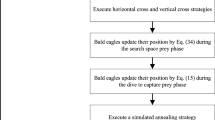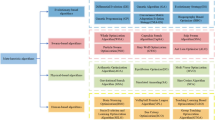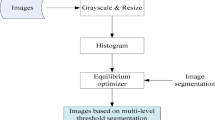Abstract
Segmentation is an essential processing step in computer vision. As a popular method in image segmentation, the pivotal of multilevel thresholding lies in determining specific thresholds of the image. In this paper, we introduce an enhanced Giza pyramids construction algorithm (GPC) with a gradient contour approach, termed GGPC, for solving color image segmentation problems. In the proposed GGPC algorithm, the gradient contour approach explores the fitness landscape based on population distributions to speculate promising summits, and provides an efficient guidance for further evolution. A composite suit of benchmark functions is adopted to evaluate the proposed GGPC algorithm which is shown via extensive comparisons to outperform eight state-of-the-art algorithms. To further develop the application potential, we propose an excellent GGPC-based thresholding segmentation method by multilevel Kapur entropy. The method is successfully exploited in color image segmentation with respect to different categories of benchmark images. Experiment results demonstrate that the GGPC-based segmentation method also exhibits better performance over peers, providing a more effective technique for color image segmentation.






Similar content being viewed by others
Explore related subjects
Discover the latest articles, news and stories from top researchers in related subjects.References
He K, Gkioxari G, Dollar P et al (2020) Mask R CNN. IEEE T Pattern Anal 42:386–397. https://doi.org/10.1109/TPAMI.2018.2844175
Manzke R, Meyer C, Ecabert O et al (2010) Automatic segmentation of rotational X-ray images for anatomic intra-procedural surface generation in atrial fibrillation ablation procedures. IEEE T Med Imaging 29 (2):260C272. https://doi.org/10.1109/TMI.2009.2021946
Yang Y, Tian D, Wu B (2018) A fast and reliable noise-resistant medical image segmentation and bias field correction model. Magn Reson Imaging 54:15–31. https://doi.org/10.1016/j.mri.2018.06.015
Tuan TM, Ngan TT, Son LH (2016) A novel semi-supervised fuzzy clustering method based on interactive fuzzy satisficing for dental x-ray image segmentation. Appl Intell 45:402C428. https://doi.org/10.1007/s10489-016-0763-5
Zhao W, Lou M, Qi Y et al (2021) Adaptive channel and multiscale spatial context network for breast mass segmentation in full-field mammograms. Appl Intell 51:8810C8827. https://doi.org/10.1007/s10489-021-02297-3
Kamel M, Zhao A (1993) Extraction of binary character/graphics images from grayscale document images. Models Image Process 55(3):203–217. https://doi.org/10.1006/gmip.1993.1015
Bhanu B (1986) Automatic target recognition: state of the art survey. IEEE T Aero Elec Sys 22:364–379. https://doi.org/10.1109/TAES.1986.310772
Sezgin M, Tasaltin R (2000) A new dichotomization technique to multilevel thresholding devoted to inspection applications. Pattern Recogn Lett 21:151–161. https://doi.org/10.1016/S0167-8655(99)00142-7
Zhenfeng S, Weixun Z, Xueqing D et al (2020) Multilabel remote sensing image retrieval based on fully convolutional network. IEEE J-Stars 13:318–328. https://doi.org/10.1109/JSTARS.2019.2961634
Farhat W, Sghaier H, Faiedh H et al (2019) Design of efficient embedded system for road sign recognition. J Ambient Intell Humaniz Comput 10:491–507. https://doi.org/10.1007/s12652-017-0673-3
Ahmadi SBB, Zhang G, Rabbani M et al (2020) An intelligent and blind dual color image watermarking for authentication and copyright protection. Appl Intell 51:1701C1732. https://doi.org/10.1007/s10489-020-01903-0
Xing ZK (2020) An improved emperor penguin optimization based multilevel thresholding for color image segmentation. Knowl-Based Syst 194:105570. https://doi.org/10.1016/j.knosys.2020.105570
Houssein EH, Neggaz N, Hosney ME, Mohamed WM, Hassaballah M (2021) Enhanced Harris hawks optimization with genetic operators for selection chemical descriptors and compounds activities Neural Comput Appl 1C18. https://doi.org/10.1007/s00521-021-05991-y
Hashim FA, Houssein EH, Hussain K et al (2020) A modified henry gas solubility optimization for solving motif discovery problem. Neural Comput Appl 32(14):10759C10771. https://doi.org/10.1007/s00521-019-04611-0
Satapathy SC, Raja NSM, Rajinikanth V et al (2018) Multi-level image thresholding using Otsu and chaotic bat algorithm. Neural Comput Appl 29(12):1285–1307. https://doi.org/10.1007/s00521-016-2645-5
Levinshtein A, Stere A, Kutulakos KN, et al. (2009) Turbopixels: fast superpixels using geometric flows. IEEE T Pattern Anal 31(12):2290–2297. https://doi.org/10.1007/10.1109/TPAMI.2009.96
He C, Li S, Xiong D (2020) Remote sensing image semantic segmentation based on edge information guidance. Remote Sens 12:1501. https://doi.org/10.3390/rs12091501
Keuper M, Tang S, Andres B et al (2020) Motion Segmentation and Multiple Object Tracking by Correlation Co-Clustering. IEEE T Pattern Anal 42:140–153. https://doi.org/10.1109/TPAMI.2018.2876253
Shao Z, Zhou W, Deng X, et al. (2020) Multilabel remote sensing image retrieval based on fully convolutional network. IEEE J-Stars 13:318–328. https://doi.org/10.1109/JSTARS.2019.2961634
Zhou Z, Siddiquee MMR, Tajbakhsh N, et al. (2020) UNet plus plus: redesigning skip connections to exploit multiscale features in image segmentation. IEEE T Med Imaging 42:140–153. https://doi.org/10.1109/TMI.2019.2959609
Stutz D, Hermans A, Leibe B (2018) Superpixels: an evaluation of the state-of-the-art. Comput Vis Image Und 166:1–27. https://doi.org/10.1016/j.cviu.2017.03.007
Ciecholewski M (2015) Automated coronal hole segmentation from Solar EUV images using the watershed transform. J Vis Commun Image R 33:203–218. https://doi.org/10.1016/j.jvcir.2015.09.015
Cousty J, Bertrand G, Najman L et al (2010) Watershed cuts: thinnings, shortest path forests, and topological watersheds. IEEE T Pattern Anal 32:925C939. https://doi.org/10.1109/TPAMI.2009.71
Breve F (2019) Interactive image segmentation using label propagation through complex networks. Expert Syst Appl 123:18–33. https://doi.org/10.1016/j.eswa.2019.01.031
Lang C, Jia H (2019) Kapurs entropy for color image segmentation based on a hybrid whale optimization algorithm. Entropy-Switz 123:18–33. https://doi.org/10.3390/e21030318
Zhao D, Liu L, Yu F, et al. (2021) Chaotic random spare ant colony optimization for multi-threshold image segmentation of 2D Kapur entropy. Knowl-Based Syst 216:106510. https://doi.org/10.1016/j.knosys.2020.106510
Back AD, Angus D, Wiles J (2020) Transitive entropy-a rank ordered approach for natural sequences. IEEE J-STSP 14:312–321. https://doi.org/10.1109/JSTSP.2019.2939998
Wu C, Cao Z (2021) Entropy-like divergence based kernel fuzzy clustering for robust image segmentation. Expert Syst Appl 169:114327. https://doi.org/10.1016/j.eswa.2020.114327
Oliveira RB, Papa JP, Pereira AS (2018) Computational methods for pigmented skin lesion classification in images: review and future trends. Neural Comput Appl 29(3):613–636. https://doi.org/10.1007/s00521-016-2482-6
Gupta S, Deep K (2020) Hybrid sine cosine artificial bee colony algorithm for global optimization and image segmentation. Neural Comput Appl 32(13):9521C9543. https://doi.org/10.1007/s00521-019-04465-6
Abdel-Basset M, Chang V, Mohamed R (2020) A novel equilibrium optimization algorithm for multi-thresholding image segmentation problems. Neural Comput Appl 1:1C34. https://doi.org/10.1007/s00521-020-04820-y
Dhal KG, Das A, Rag S, et al. (2019) Nature-inspired optimization algorithms and their application in multi-thresholding image segmentation. Arch Comput Method E 27(3):855–888. https://doi.org/10.1007/s11831-019-09334-y
Pare S, Kumar A, Bajaj V (2017) An efficient method for multilevel color image thresholding using cuckoo search algorithm based on minimum cross entropy. Appl Soft Comput 61:570–592. https://doi.org/10.1016/j.asoc.2017.08.039
Zhao D, Liu L, Yu F, Heidari AA, et al. (2020) Ant colony optimization with horizontal and vertical crossover search: fundamental visions for multi-threshold image segmentation. Expert Syst Appl 167:14122. https://doi.org/10.1016/j.eswa.2020.114122
Rodriguez-Esparza E, Zanella-Calzada LA, Oliva D et al (2020) An efficient Harris hawks-inspired image segmentation method. Expert Syst Appl 155:113428. https://doi.org/10.1016/j.eswa.2020.113428
Mirghasemi S, Yazdi HS, Lotfizad M (2012) A target-based color space for sea target detection. Appl Intell 36:960C978. https://doi.org/10.1007/s10489-011-0307-y
Yang Z, Angus W (2020) A non-revisiting quantum-behaved particle swarm optimization based multilevel thresholding for image segmentation. Neural Comput Appl 32(16):12011C12031. https://doi.org/10.1007/s00521-019-04210-z
Mirjalili S (2015) The ant lion optimizer. Adv Eng Softw 83:80–98. https://doi.org/10.1016/j.advengsoft.2015.01.010
Mirjalili S (2015) Moth-flame optimization algorithm: a novel nature-inspired heuristic paradigm. Knowl-Based Syst 89:228–249. https://doi.org/10.1016/j.knosys.2015.07.006
Jia H, Peng X, Song W et al (2019) Multiverse optimization algorithm based on levy flight improvement for multithreshold color image segmentation. IEEE Access 7:32805–32844. https://doi.org/10.1109/ACCESS.2019.2903345
Wei D, Wang Z, Si L et al (2021) Preaching-inspired swarm intelligence algorithm and its applications. Knowl-Based Syst 211:106552. https://doi.org/10.1016/j.knosys.2020.106552
Gupta S, Deep K (2019) Improved sine cosine algorithm with crossover scheme for global optimization. Knowl-Based Syst 165:374–406. https://doi.org/10.1016/j.knosys.2018.12.008
Aziz MAE, Ewees AA, Hassanien AE (2017) Whale Optimization Algorithm and Moth-Flame Optimization for multilevel thresholding image segmentation. Expert Syst Appl 83:242–256. https://doi.org/10.1016/j.eswa.2017.04.023
Pan Y, Xia Y, Zhou T et al (2017) Cell image segmentation using bacterial foraging optimization. Appl Soft Comput 58:770C782. https://doi.org/10.1016/j.asoc.2017.05.019
Singh S, Mittal N, Singh H (2020) A multilevel thresholding algorithm using LebTLBO for image segmentation. Neural Comput Appl 32:16681C16706. https://doi.org/10.1007/s00521-020-04989-2
Ashish KB (2020) A novel beta differential evolution algorithm-based fast multilevel thresholding for color image segmentation. Neural Comput Appl 32(9):4583–4613. https://doi.org/10.1007/s00521-018-3771-z
Omar A, Ernesto A, Fernando W, Marco PC (1005) An accurate Cluster chaotic optimization approach for digital medical image segmentation. Neural Comput Appl 33:10057C10091. https://doi.org/10.1007/s00521-021-05771-8
Sun Y, Yen GG, Yi Z (2018) Evolving unsupervised deep neural networks for learning meaningful representations. IEEE T Evolut Comput 23(1):89–103. https://doi.org/10.1109/TEVC.2018.2808689
Omidvar M, Li X, Yao X (2021) A review of population-based metaheuristics for large-scale black-box global optimization: Part B. IEEE T Evolut Comput 26(5):823–843. https://doi.org/10.1109/TEVC.2021.3130835
Woo DK, Choi JH, Ali M, et al. (2011) A novel multimodal optimization algorithm applied to electromagnetic optimization. IEEE T Magn 47(6):1667–1673. https://doi.org/10.1109/TMAG.2011.2106218
Zheng Y, Du Y, Ling H et al (2019) Evolutionary collaborative human-UAV search for escaped criminals. IEEE T Evolut Comput 24(2):217–231. https://doi.org/10.1109/TEVC.2019.2925175
Zaman F, Elsayed SM, Ray T, et al. (2017) Evolutionary algorithms for finding Nash equilibria in electricity markets. IEEE T Evolut Comput 22(4):536–549. https://doi.org/10.1109/TEVC.2017.2742502
Harifi S, Mohammadzadeh J, Khalilian M, et al. (2021) Giza pyramids Construction: an ancient-inspired metaheuristic algorithm for optimization. Evol Comput 4(14):1743–1761. https://doi.org/10.1007/s12065-020-00451-3
Song B, Wang Z, Zou L (2017) On global smooth path planning for mobile robots using a novel multimodal delayed PSO algorithm. Cogn Comput 9:5–17. https://doi.org/10.1007/s12559-016-9442-4
Lin Y, Zhang J, Lan L (2008) A contour method in population-based stochastic algorithms. In: Proceedings of the 2008 IEEE congress on evolutionary computation. IEEE, pp 2388–2395. https://doi.org/10.1109/CEC.2008.4631117
Wang Z, Zhan Z, Lin Y et al (2020) Automatic Niching differential evolution with contour prediction approach for Multimodal optimization problems. IEEE T Evolut Comput 1(24):124–128. https://doi.org/10.1109/TEVC.2019.2910721
Zhang MJ, Smart W (2004) Genetic programming with gradient descent search for multiclass object classification. In: Proceedings of the 7th European conference on genetic programming. Springer, pp 399–408. https://doi.org/10.1007/978-3-540-24650-338
Hinton GE, Salakhutdinov RR (2006) Reducing the dimensionality of data with neural networks. Science 313(5786):504–507. https://doi.org/10.1126/science.1127647
Otsu NA (2007) Threshold selection method from gray-level histograms. IEEE T Syst Man Cy-S 1(9):62–66. https://doi.org/10.1109/TSMC.1979.4310076
Bandopadhyay R, Kundu R, Oliva D (2021) Segmentation of brain mri using an altruistic harris hawks optimization algorithm. Knowl-Based Syst 232:107468. https://doi.org/10.1016/j.knosys.2021.107468
Levine MD, Nazif AM (1985) Dynamic measurement of computer generated image segmentations. IEEE T Pattern Anal 7(2):155–164. https://doi.org/10.1109/tpami.1985.4767640
Sahoo PK, Soltani S, Wong AKC (1988) A survey of thresholding techniques. Graph Models 41:233–260. https://doi.org/10.1016/0734-189X(88)90022-9
Zhang H, Fritts JE, Goldman SA (2008) Image segmentation evaluation: a survey of unsupervised methods. Comput Vis Image Und 2(110):260–280. https://doi.org/10.1016/j.cviu.2007.08.003
Rosenberger C, Chabrier S, Laurent H, Emile B (2006) Unsupervised and supervised image segmentation evaluation. In: Zhang YJ (ed) Advances in image and video segmentation, IRM Press: Pennsylvania, USA, vol 18, pp 365C393
Kapur JN, Sahoo PK, Wong AKC (1985) A new method for gray-level picture thresholding using the entropy of histogram. Graph Models 29(1):273–285. https://doi.org/10.1016/S0734-189X(85)90156-2
Wu Y, Ji S (2010) Multi threshold selection for an image based on gray entropy and chaotic particle swarm optimization. CAAI Transactions on Intelligence Systems 5(6):522–529. https://doi.org/10.3969/j.issn.1673-4785.2010.06.009
Li CH, Lee CK (1996) Minimum cross entropy thresholding. Pattern Recogn 29(4):575–580. https://doi.org/10.1016/0031-3203(93)90115-D
Bergh F, Engelbrecht AP (2005) A study of particle swarm optimization particle trajectories. Inform Sciences 176:937–971. https://doi.org/10.1016/j.ins.2005.02.003
Funding
This research was funded by Fundamental Research Funds of Central Universities (2572018BF02), National Natural Science Foundation of China (31370710), Forestry Science and Technology Extension Project (2016[34]), the 948 Project from the Ministry of Forestry of China (2014-4-46) and the Postdoctoral Research Fund of Heilongjiang Province (LBH-Q13007)
Author information
Authors and Affiliations
Contributions
W.B. and Z.L. contributed to the idea of this paper; W.B. performed the experiments; All authors analyzed data; W.B. wrote the manuscript; W.B. and Z.L. contributed to the revision of this paper.
Corresponding author
Ethics declarations
Ethics
standard This article does not contain any studies with human participants or animals performed by any of the authors.
Conflict of Interests
The authors declare no conflict of interest.
Additional information
Publisher’s note
Springer Nature remains neutral with regard to jurisdictional claims in published maps and institutional affiliations.
Liangkuan Zhu and Xin Li contributed equally to this work.
Rights and permissions
Springer Nature or its licensor (e.g. a society or other partner) holds exclusive rights to this article under a publishing agreement with the author(s) or other rightsholder(s); author self-archiving of the accepted manuscript version of this article is solely governed by the terms of such publishing agreement and applicable law.
About this article
Cite this article
Wu, B., Zhu, L. & Li, X. Giza pyramids construction algorithm with gradient contour approach for multilevel thresholding color image segmentation. Appl Intell 53, 21248–21267 (2023). https://doi.org/10.1007/s10489-023-04512-9
Accepted:
Published:
Issue Date:
DOI: https://doi.org/10.1007/s10489-023-04512-9




